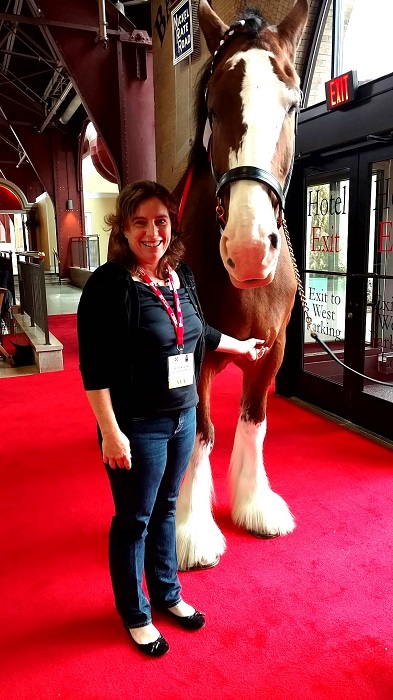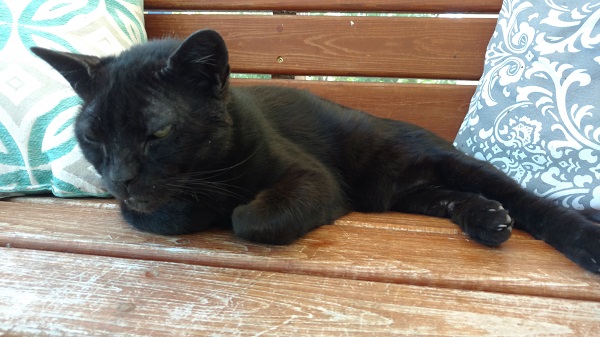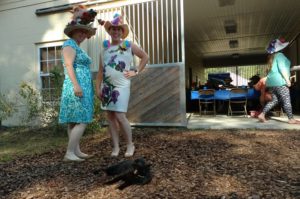
Dr. Lacher’s Trip To Purina
Tuesdays with Tony
I eat Purina cat food. Dr. Lacher told me she was going to the Purina research facility, so naturally I felt I should get some food out of the deal. Turns out Purina horse and Purina cat aren’t the same thing, so I didn’t get anything out of this deal. However, Dr. Lacher said she learned a ton, so read on to hear about her trip to St. Louis. Here’s what she said about it:
The first thing I’m going to say about this trip is that Purina was all about the science. While they flew us to St. Louis, put us up in an amazing hotel (check out the St. Louis Grand Central Station Hotel), and fed us very well, the information presented wasn’t about Purina. Instead, it was about the science behind fueling and caring for horses. They also talked about how they use that science to make better feeds, and how they make sure the research they do gets published so horses everywhere can benefit.
 We started off the evening by meeting these guys: Rascal and McGee. I have been around the Anheuser Busch Clydesdales before but I find their size awe-inspiring every time. I also find their tolerance for the crazy stuff they are asked to do pretty impressive. Rascal and McGee spent two hours standing in a hotel lobby (on a red carpet with padding underneath) being incredibly bored while 250-300 veterinarians and technicians oohh’d and aaahh’d over them, took selfies, marveled at their feathers, their extreme level of clean, and how they did their hair, and never once lost their cool. I can’t get Vespa to calmly stand on crossties in the barn at home reliably!
We started off the evening by meeting these guys: Rascal and McGee. I have been around the Anheuser Busch Clydesdales before but I find their size awe-inspiring every time. I also find their tolerance for the crazy stuff they are asked to do pretty impressive. Rascal and McGee spent two hours standing in a hotel lobby (on a red carpet with padding underneath) being incredibly bored while 250-300 veterinarians and technicians oohh’d and aaahh’d over them, took selfies, marveled at their feathers, their extreme level of clean, and how they did their hair, and never once lost their cool. I can’t get Vespa to calmly stand on crossties in the barn at home reliably!
The next day I learned how hard it is to treat ulcers in horses. Don’t get me wrong, I know we have the chronic offenders. Those horses we treat for ulcers again and again and again. Now, thanks to an incredibly scrappy Australian, I understand why it’s so difficult to get some of these horses managed! Gastrogard is difficult to give correctly, and some horses produce lots of acid no matter how much Gastrogard you give them, and some horses get ulcers in the glandular part of the stomach and they need a whole different plan.
To get your money’s worth from Gastrogard (and it’s a lot of money):
- Keep your horse in a stall overnight
- Give no food after 10pm (although they can have a flake of hay at 10pm)
- Give Gastrogard in the morning BEFORE feeding
- Wait at least 1 ½ hours to feed
- Repeat for three weeks.
In the afternoon we all piled into buses and drove about an hour away to the Purina Research Farm. This is about 1200 acres of beautiful rolling fields dotted with cows, chickens, goats, sheep, horses, and even a research pond! Here Purina begins the process of making their feed better. They take an idea, turn it into a feed (or add it to an already available feed), and put it to the test on actual animals in real world situations! They can tell if horses are eating big bites or little bites of grain, how fast they are eating, do they eat hay and then grain, or grain and then hay, and even do they like this better than that down to 0.01 pounds. At this point I was thinking being a research horse for Purina is a pretty cushy job. Then we went to the treadmill barn.
The treadmill horses tell Purina if their feed improves performance in an actual test of performance. These studies are over a prolonged period, sometimes as long as 8-12 months. During that time the horse’s fitness is tested by a myriad of machines. They look at heart rate, return-to-resting heart rate, what they breathe out vs. what they breathe in, and if it’s a marker of how a horse’s metabolism is working, they measure it. This takes the guesswork out of knowing if a tweak to a diet makes a real difference. Science tells them yes or no. Here’s the cool thing: if the answer is no, no matter how badly they want it to be yes, Purina doesn’t make the change.
The final stop on the Purina Farm tour was what they call the Microbiome Barn. Everyone agrees the microscopic critters on and in a body (horse or human) are important in ways we never dreamed. However, no one is really sure what bacteria, fungus, and protozoa are involved, how to influence these critters, if we even can influence them, and do good or bad (or nothing) things happen when we do try to influence them. Purina has a group of horses dedicated to this research. They are in the very early phases, but it’s pretty exciting stuff!!
Sunday was another day of science!! I am often frustrated by the horse who seems to have weird GI stuff going on: diarrhea for months or years, weight loss in the senior horse, and the repeat offender colic horse. We talked about diagnosing and treating these horses. Then we talked about how different components of the diet can impact these horses. Sure, there were suggestions on which Purina diets had these ingredients, but the overriding message was about ingredients, not diets in particular. Needless to say, I learned a lot this weekend!!
There you have it. I’m glad Dr. Lacher learned a lot and enjoyed herself, but next time I want food! That’s reasonable, right?
Until next week,
Tony
Tuesdays with Tony is the official blog of Tony the Clinic Cat at Springhill Equine Veterinary Clinic in Newberry, Florida. If you liked this blog, please subscribe below, and share it with your friends on social media! For more information, please call us at (352) 472-1620, visit our website at SpringhillEquine.com, or follow us on Facebook!
[jetpack_subscription_form title="Subscribe to Whinny's Wisdoms"]



 for me, so that’s really not my thing at all. Anyway, the race was very exciting, especially the saddle-bronc bucking display coming out of the gate! Thoroughbreds are certainly majestic and athletic creatures. But, as a cat who works at a vet clinic, I can’t watch Thoroughbreds without thinking about stomach ulcers. Comes with the trade, I guess!
for me, so that’s really not my thing at all. Anyway, the race was very exciting, especially the saddle-bronc bucking display coming out of the gate! Thoroughbreds are certainly majestic and athletic creatures. But, as a cat who works at a vet clinic, I can’t watch Thoroughbreds without thinking about stomach ulcers. Comes with the trade, I guess!